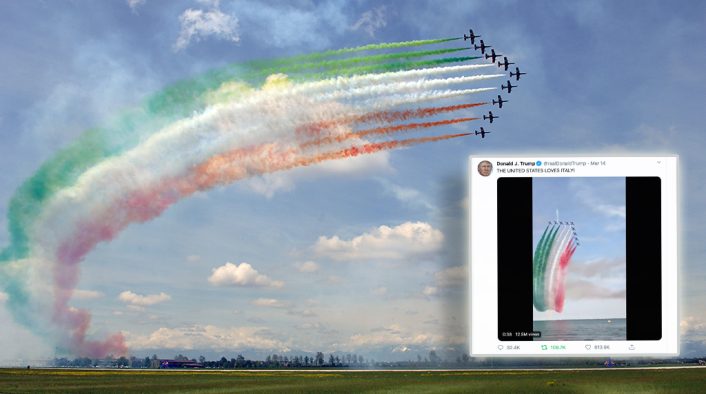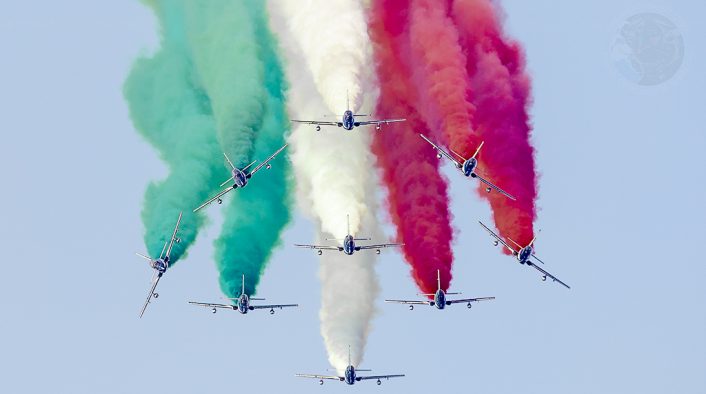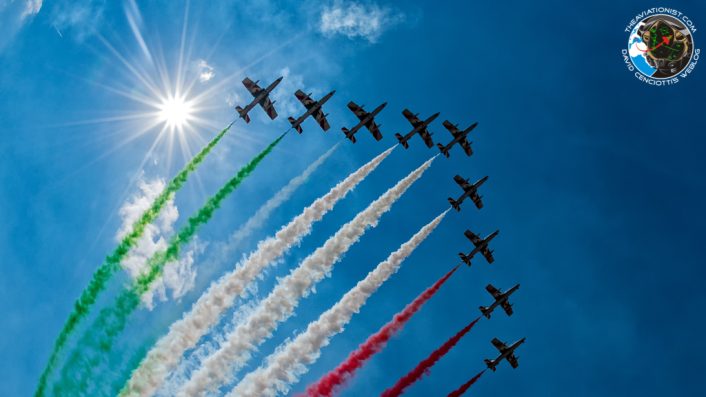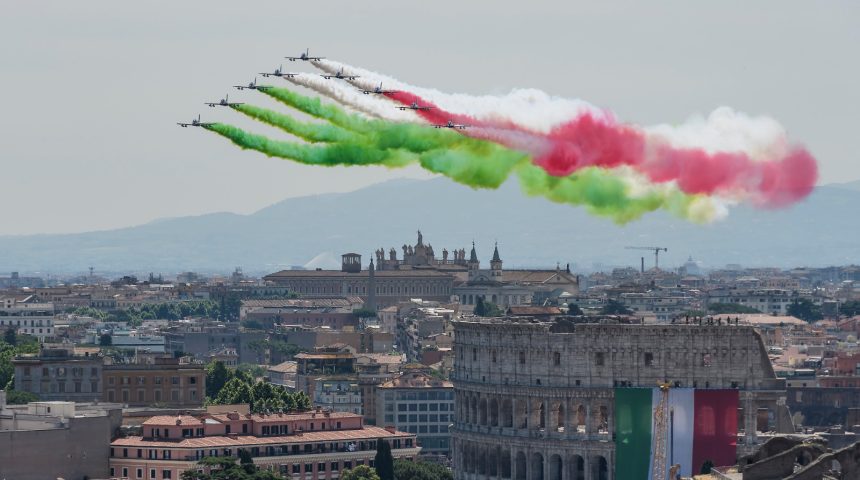The Frecce Tricolori is the Italian Air Force aerobatic display team. It’s the world’s largest military display team.
On Mar. 1, 2021 the Frecce Tricolori, the display team of the Aeronautica Militare (Italian Air Force), celebrated their 60th anniversary.
The unit, also known as the Pattuglia Acrobatica Nazionale (PAN, Italian Aerobatic Team) is, undoubtedly, the most popular and visible component of the Italian Air Force as well as a symbol of Italy: with its 10 Italian built aircraft – the MB.339A/PAN – the “Frecce” (Italian for “Arrows”) – form one of the world’s most prestigious aerobatic teams which offers, in around 25 minutes of display, a show that is almost unforgettable even to the most knowledgeable spectators, together with a demonstration of capacity, courage, pride of an entire Nation.
The Italian Aerobatic Team is assigned to the 313° Gruppo Addestramento Acrobatico (Aerobatic Training Squadron) based at Rivolto Air Base, in northeastern Italy. The Frecce Tricolori are tasked with “representing the Air Force and Italy in both national and international air displays, and demonstrating, through the execution of collective aerobatic flight programmes, not only their professional and technical skills, but also the inventiveness and courage of an entire Armed Force and of Italy.”

The aircraft
The team is equipped with the PAN version of the MB-339A, a single engine tandem seat training and tactical support aircraft. Apart from the livery, the 313° Gruppo aircraft differ from the standard model serving with the Aeronautica Militare by the presence onboard of the coloured smokes generation system: this device is controlled by two buttons: one on the stick, for white smoke, and one on the throttle for coloured smoke. The system is fed from an under wing fuel tank filled with a colouring agent which is discharged through nozzles placed in the jet exhaust. The agent, vaporised in the jet exhaust, produces a coloured trail.

Another PAN aircraft’s peculiarity is that in order to enhance manoeuvrability along the aircraft longitudinal (roll) axis, and to reduce wing loading, it flies with no tip tanks. These are cylindrical 510 litre tanks which are only mounted on the aircraft for long-range ferry flights. They are replaced by an ad hoc wingtip fairing which covers the wingtip tank attachment points. Since 2002, the PAN also received Mid Life Updated MB-339s. This MLU programme has integrated the previous series models with updated structural features and avionics, such as GPS, formation flying position lights, a new V/UHF radio equipped with a new tail antenna, in addition to reinforced nose and tail. The MB-339 has equipped the PAN since 1982, when it replaced the FIAT G.91, a light fighter bomber aircraft which entered service with the Frecce Tricolori in 1963. The “Pattuglia”’s “Gina”, with its characteristic pointed nose, was the pre series version stripped of the photo reconnaissance system and served by a modified flight control system and a smoke generation device. The G.91s replaced the PAN’s first aircraft, the Canadair CL13 “Sabre” Mk4 (F-86E), a Korean War veteran US fighter aircraft, which had been produced under licence in Canada, and then passed to the Italian Air Force by the American Government after serving with the R.A.F.
The future aircraft of the team will be the M-345 (T-345 according to the Italian MOD Mission Design Series).
Records
The Frecce Tricolori can claim a series of records. First of all its size: the Italian aerobatic team is the only one to fly with 10 aircraft.
Another singularity which makes the PAN unique is the fact that the whole display is executed in sight of the public. Separations, transformations and rejoins are always performed in front of the spectators, a circumstance which requires absolute preciseness in all phases of the display.
By the way: another record accomplished by the Frecce Tricolori is the fact that they separate into two formations (one flight of 5 and another of 4 aircraft) which then fly an opposition pass and subsequently rejoin in less than two minutes. Rejoin time is a factor that can influence deeply a flying display.
One more peculiarity of the PAN is the Downward Bomb Burst, a maneuver which has been part of the Pattuglia’s tradition since its creation, having been part of the Italian Air Force heritage for about 90 years now. It is a maneuver in which the aircraft, starting from a high altitude and in formation, dive towards the ground and then separate into 9 individual elements which depart in different directions, finally returning for an opposition pass, at three different levels, over the same point. This is a very spectacular and complex manoeuvre, which no one else is capable of reproducing, especially due to the difficulty in opposition passing and rejoining in the very short time frames required for a display.
The other record of the Frecce Tricolori is tied to the Solo’s Lomçovak. This is a display which is typically executed by propeller aircraft, and foresees a “standing roll” followed by a vertical spin, reverse and subsequent aircraft pitch down. Such a manoeuvre is usually “outside the flight envelope” for most jet aircraft, but the PAN’s Solo pilot can execute it in complete safety, thanks to the outstanding handling capabilities of the MB-339. This Author had the opportunity to fly with the Frecce Tricolori 15 years ago and experience the Lomçovak from the backseat of a 339A/PAN. It’s a totally crazy experience!










